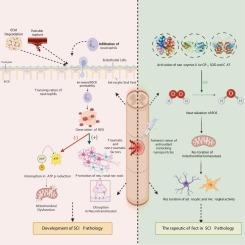Nano-shields: Exploring the role of antioxidant mimicking nanoparticles as regenerative therapy in spinal cord injury
IF 6
2区 医学
Q2 MATERIALS SCIENCE, BIOMATERIALS
Materials Science & Engineering C-Materials for Biological Applications
Pub Date : 2025-08-30
DOI:10.1016/j.bioadv.2025.214484
引用次数: 0
Abstract
Spinal cord injury presents a significant clinical challenge. There are limited treatment options, and the results of regeneration are often disappointing. Secondary injury processes, including oxidative stress and chronic inflammation, worsen nerve damage and slow recovery. New nanomaterials, particularly antioxidant-mimicking nanoparticles known as nanozymes, offer a promising way to improve the injury microenvironment and aid nerve regeneration. These nanozymes mimic natural enzyme activity by scavenging reactive oxygen species and reducing inflammation. Materials like cerium oxide, gold, and platinum-based nanoparticles show strong catalytic and antioxidant abilities. Their effectiveness is influenced by factors like pH, redox state, and levels of hydrogen peroxide or glutathione. Their stability, adaptability, and ability to be produced on a large scale make them promising options in regenerative medicine and drug development. In this special issue, we offer an overview of the development, functions, and healing potential of nanozyme-based systems for spinal cord injury. We highlight their potential as next-generation materials for nerve repair.

纳米屏障:探索抗氧化剂模拟纳米颗粒在脊髓损伤再生治疗中的作用
脊髓损伤是一个重大的临床挑战。治疗选择有限,再生的结果往往令人失望。继发性损伤过程,包括氧化应激和慢性炎症,加重神经损伤和缓慢恢复。新的纳米材料,特别是被称为纳米酶的抗氧化剂模拟纳米材料,为改善损伤微环境和帮助神经再生提供了一种有希望的方法。这些纳米酶通过清除活性氧和减少炎症来模拟天然酶的活性。诸如氧化铈、金和铂基纳米颗粒等材料显示出很强的催化和抗氧化能力。它们的有效性受到pH值、氧化还原状态、过氧化氢或谷胱甘肽水平等因素的影响。它们的稳定性、适应性和大规模生产的能力使它们成为再生医学和药物开发的有希望的选择。在这期特刊中,我们概述了纳米酶为基础的脊髓损伤系统的发展、功能和愈合潜力。我们强调它们作为下一代神经修复材料的潜力。
本文章由计算机程序翻译,如有差异,请以英文原文为准。
求助全文
约1分钟内获得全文
求助全文
来源期刊
CiteScore
17.80
自引率
0.00%
发文量
501
审稿时长
27 days
期刊介绍:
Biomaterials Advances, previously known as Materials Science and Engineering: C-Materials for Biological Applications (P-ISSN: 0928-4931, E-ISSN: 1873-0191). Includes topics at the interface of the biomedical sciences and materials engineering. These topics include:
• Bioinspired and biomimetic materials for medical applications
• Materials of biological origin for medical applications
• Materials for "active" medical applications
• Self-assembling and self-healing materials for medical applications
• "Smart" (i.e., stimulus-response) materials for medical applications
• Ceramic, metallic, polymeric, and composite materials for medical applications
• Materials for in vivo sensing
• Materials for in vivo imaging
• Materials for delivery of pharmacologic agents and vaccines
• Novel approaches for characterizing and modeling materials for medical applications
Manuscripts on biological topics without a materials science component, or manuscripts on materials science without biological applications, will not be considered for publication in Materials Science and Engineering C. New submissions are first assessed for language, scope and originality (plagiarism check) and can be desk rejected before review if they need English language improvements, are out of scope or present excessive duplication with published sources.
Biomaterials Advances sits within Elsevier''s biomaterials science portfolio alongside Biomaterials, Materials Today Bio and Biomaterials and Biosystems. As part of the broader Materials Today family, Biomaterials Advances offers authors rigorous peer review, rapid decisions, and high visibility. We look forward to receiving your submissions!

 求助内容:
求助内容: 应助结果提醒方式:
应助结果提醒方式:


